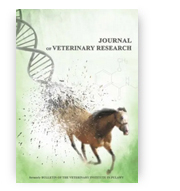An initial characterisation of the Unfolded Protein Response pathway in haematopoietic canine cancer cell lines – a necessary step for the future development of new therapies in dogs with neoplasia
Beatriz Hernandez-Suarez; David A. Gillespie; Bożena Obmińska-Mrukowicz; Aleksandra Pawlak
Journal of Veterinary Research
Ministerial score = 200.0
Journal Impact Factor (2023) = 1.8 (Q2)
 Introduction: New and more effective therapies for canine cancer patients are urgently required and this necessitates advanced experimental research. Dogs are good models for studies in comparative oncology; however, canine cancer cell biology research is currently limited by low availability of validated antibody reagents and techniques. This study characterises the expression of key components of the unfolded protein response (UPR) in a panel of haematopoietic canine cancer cell lines using commercially available antibodies, and validates the methods used to study this pathway. Material and Methods: The CLBL-1 canine lymphoma cell line and the GL-1 canine leukaemia cell line sourced externally and two counterparts established in house (CNK-89 and CLB70) were used as models of different lymphoma and leukaemia canine cell lines for the study. The human U2OS cell line served as the control. Antibodies were selected for identifying UPR proteins according to known canine cell reactivity and canine–murine and canine–human homology. Endoplasmic reticulum stress was induced with thapsigargin and MG132 in the cell lines. Etoposide was used to induce DNA damage in the cells. The techniques used for this validation analysis were RNA sequencing to observe the expression of UPR components in canine cell lines, Western blot to observe changes of protein expression levels after inducing ER stress in the cells, and flow cytometry in order to study cell death. Results: Substantial variations in both the basic expression and agonist-induced activation of the UPR pathway were observed in canine cancer cell lines, although the biological significance of these differences requires further investigation. Conclusion: These findings will be a starting point for uture studies on cancer biology in dogs. They will also contribute to developing novel anticancer therapies for canine patients and may provide new insights into human oncology.
Introduction: New and more effective therapies for canine cancer patients are urgently required and this necessitates advanced experimental research. Dogs are good models for studies in comparative oncology; however, canine cancer cell biology research is currently limited by low availability of validated antibody reagents and techniques. This study characterises the expression of key components of the unfolded protein response (UPR) in a panel of haematopoietic canine cancer cell lines using commercially available antibodies, and validates the methods used to study this pathway. Material and Methods: The CLBL-1 canine lymphoma cell line and the GL-1 canine leukaemia cell line sourced externally and two counterparts established in house (CNK-89 and CLB70) were used as models of different lymphoma and leukaemia canine cell lines for the study. The human U2OS cell line served as the control. Antibodies were selected for identifying UPR proteins according to known canine cell reactivity and canine–murine and canine–human homology. Endoplasmic reticulum stress was induced with thapsigargin and MG132 in the cell lines. Etoposide was used to induce DNA damage in the cells. The techniques used for this validation analysis were RNA sequencing to observe the expression of UPR components in canine cell lines, Western blot to observe changes of protein expression levels after inducing ER stress in the cells, and flow cytometry in order to study cell death. Results: Substantial variations in both the basic expression and agonist-induced activation of the UPR pathway were observed in canine cancer cell lines, although the biological significance of these differences requires further investigation. Conclusion: These findings will be a starting point for uture studies on cancer biology in dogs. They will also contribute to developing novel anticancer therapies for canine patients and may provide new insights into human oncology.
DOI:10.2478/jvetres-2023-0042









